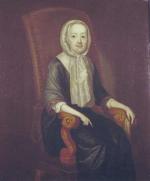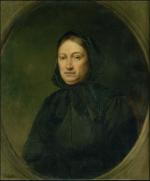![header=[Marker Text] body=[Born in 1671, she married William Penn, 1696. They lived at Pennsbury, and in the Slate Roof House here, 1699–1701. During his final illness, 1712–18, and until her death, 1726, she was Pensylvania's acting proprietor. She was the only woman to control a British proprietary colony for so long.
] sign](http://explorepahistory.com/kora/files/1/10/1-A-20-139-ExplorePAHistory-a0a1l7-a_450.gif)
Mouse over for marker text
Name:
Hannah Callowhill Penn
Region:
Philadelphia and its Countryside/Lehigh Valley
County:
Philadelphia
Marker Location:
2nd Street near Walnut Street, Philadelphia
Dedication Date:
October 24, 2000
Behind the Marker
On First Day (a day better known as "Sunday" to non-Quakers), December 10, 1699, after eight long, difficult weeks at sea, Hannah Callowhill Penn arrived in Philadelphia on board the Canterbury with her husband. While William Penn's trusted secretary, James Logan, instructed dockworkers and servants to gather up crates of their belongings, Penn escorted Hannah, as she carefully made her way down the gangplank into his bustling "greene country town." She was pregnant and due to give birth to their first child in about a month.
Twenty-six years old when she arrived in Philadelphia, Hannah was twenty-four years younger than her famous husband. Penn's first wife, Gulielma Maria Springett, had died on February 24, 1694, leaving her husband to care for their two surviving children, Laetitia and William Penn, Jr. While her brother stayed in England, Laetitia came to the colony with her father and stepmother.
Born in Bristol, England, Hannah Callowhill was the only surviving daughter of a wealthy merchant. She first met Penn when he was on a religious visit to fellow Quakers in her city. After he left, they began a courtship through letters. The exchange of notes, however, was not equal, for her suitor wrote more than twice as many letters as Hannah did and in one missive gently chided her for not keeping up a more regular correspondence. Despite her apparent laxity in letter writing, Penn proposed and she accepted. The two were married in the Friends Meeting House in Bristol on March 5, 1696.
Upon their arrival in Pennsylvania, the Penns made their way through a welcoming throng of officials and well wishers to the home of Edward Shippen, a prominent Quaker and close friend of William Penn, where they would stay for a few weeks. Penn's manor home, Pennsbury, was not yet ready for them to take up residence. After a short stay at Shippen's, they moved into the Slate Roof House located at Second Street and Norris Alley (now Sansom Street) which was owned by a Quaker merchant and Provincial Council member, Samuel Carpenter. Here Hannah Penn gave birth to a son, John.
Pennsbury, was not yet ready for them to take up residence. After a short stay at Shippen's, they moved into the Slate Roof House located at Second Street and Norris Alley (now Sansom Street) which was owned by a Quaker merchant and Provincial Council member, Samuel Carpenter. Here Hannah Penn gave birth to a son, John.
By June their steward had everything ready for them at Pennsbury and they relocated to their country estate situated on the Delaware twenty-four miles above Philadelphia. There, Hannah took responsibility for management of the manor's household activities, including the baking, brewing, cooking, drying, pickling, preserving and spinning. As mistress of the manor, she was in charge of the cellar, dairy, herb garden, larder, kitchen garden, and smokehouse and managed the domestic workforce, which included at least three African-American slaves.
The Penn family had only been in America about a year when economic and political necessity forced Penn to return to England in 1701. His money problems were twofold: Penn's representatives were having trouble collecting rents from tenants on his lands in Ireland, and his business agent in London, Philip Ford, claimed that Penn owed him ten thousand pounds sterling. Penn's most significant political problem stemmed from efforts by the royal government to take control of Pennsylvania. These were serious problems that required his direct personal attention.
Penn wanted to leave Hannah and Laetitia in Pennsylvania but they insisted that they accompany him. On November 2, 1701, Hannah Penn again boarded a ship with all her belongings to cross the Atlantic. When she arrived in England two months later, she was pregnant with her second child. In England, Hannah Penn would have five more children.
After Penn became ill in 1712 and suffered a series of debilitating strokes during the following year, she also had to take care of her ailing husband. When Penn became paralyzed by several strokes, Hannah ably handled all of the province's official business. She sent letters of advice and instruction to its governor Charles Gookin and to James Logan and she also handled her husband's other complicated financial and legal affairs.
After Penn's death, in July 1718, Hannah Penn had to grapple with a challenge to her husband's will. In an effort to cut Hannah and her children out of the inheritance, William Penn, Jr. mounted a legal effort to contest his father's will. Although he died before the case was settled, his son Springett attempted to have the court declare the will invalid, asserting that his grandfather was mentally incompetent when he wrote it. Hannah Penn prevailed, however, and saw to it that her children received the estate. When she died on December 20, 1726, the proprietorship of Pennsylvania passed to her three sons: John, Thomas, and Richard.
Twenty-six years old when she arrived in Philadelphia, Hannah was twenty-four years younger than her famous husband. Penn's first wife, Gulielma Maria Springett, had died on February 24, 1694, leaving her husband to care for their two surviving children, Laetitia and William Penn, Jr. While her brother stayed in England, Laetitia came to the colony with her father and stepmother.
Born in Bristol, England, Hannah Callowhill was the only surviving daughter of a wealthy merchant. She first met Penn when he was on a religious visit to fellow Quakers in her city. After he left, they began a courtship through letters. The exchange of notes, however, was not equal, for her suitor wrote more than twice as many letters as Hannah did and in one missive gently chided her for not keeping up a more regular correspondence. Despite her apparent laxity in letter writing, Penn proposed and she accepted. The two were married in the Friends Meeting House in Bristol on March 5, 1696.
Upon their arrival in Pennsylvania, the Penns made their way through a welcoming throng of officials and well wishers to the home of Edward Shippen, a prominent Quaker and close friend of William Penn, where they would stay for a few weeks. Penn's manor home,
By June their steward had everything ready for them at Pennsbury and they relocated to their country estate situated on the Delaware twenty-four miles above Philadelphia. There, Hannah took responsibility for management of the manor's household activities, including the baking, brewing, cooking, drying, pickling, preserving and spinning. As mistress of the manor, she was in charge of the cellar, dairy, herb garden, larder, kitchen garden, and smokehouse and managed the domestic workforce, which included at least three African-American slaves.
The Penn family had only been in America about a year when economic and political necessity forced Penn to return to England in 1701. His money problems were twofold: Penn's representatives were having trouble collecting rents from tenants on his lands in Ireland, and his business agent in London, Philip Ford, claimed that Penn owed him ten thousand pounds sterling. Penn's most significant political problem stemmed from efforts by the royal government to take control of Pennsylvania. These were serious problems that required his direct personal attention.
Penn wanted to leave Hannah and Laetitia in Pennsylvania but they insisted that they accompany him. On November 2, 1701, Hannah Penn again boarded a ship with all her belongings to cross the Atlantic. When she arrived in England two months later, she was pregnant with her second child. In England, Hannah Penn would have five more children.
After Penn became ill in 1712 and suffered a series of debilitating strokes during the following year, she also had to take care of her ailing husband. When Penn became paralyzed by several strokes, Hannah ably handled all of the province's official business. She sent letters of advice and instruction to its governor Charles Gookin and to James Logan and she also handled her husband's other complicated financial and legal affairs.
After Penn's death, in July 1718, Hannah Penn had to grapple with a challenge to her husband's will. In an effort to cut Hannah and her children out of the inheritance, William Penn, Jr. mounted a legal effort to contest his father's will. Although he died before the case was settled, his son Springett attempted to have the court declare the will invalid, asserting that his grandfather was mentally incompetent when he wrote it. Hannah Penn prevailed, however, and saw to it that her children received the estate. When she died on December 20, 1726, the proprietorship of Pennsylvania passed to her three sons: John, Thomas, and Richard.






